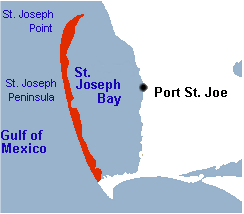St. Joseph Peninsula facts for kids
The St. Joseph Peninsula is a long, narrow piece of land in Gulf County, Florida. It's often called St. Joseph Spit because it's like a long finger of land reaching out into the water. This peninsula is about 15 miles (24 km) long. It stretches north from Cape San Blas. On its west side is the Gulf of Mexico, and on its east side is St. Joseph Bay. The closest town, Port St. Joe, is about 6 miles (9.7 km) to the east. The very tip of the peninsula is known as St. Joseph Point.
Contents
A Look Back in Time: History of the Peninsula
The St. Joseph Peninsula has a long and interesting history. People have lived here for many, many years!
Early Native American Life
Long ago, Native American groups lived on the St. Joseph Peninsula. We know this because archaeologists have found old sites like Old Cedar, Eagle Harbor, and Harrier. These sites show that people from the Weeden Island culture lived here. A "culture" means a group of people who share similar ways of life, tools, and beliefs. Later, people from the Fort Walton culture and Swift Creek culture also lived in this area. They left behind tools and other items that tell us about their lives.
Spanish and French Settlements
In the early 1500s, Spanish explorers arrived and named the bay Bahía de San José. But they didn't build anything here for a long time. In 1701, the Spanish built a fort called Presidio Bahía de San José de Valladeres on the mainland. They also had a lookout spot on St. Joseph Point. However, they left just two years later.
Then, in 1718, during a war, the French came to St. Joseph Bay. They built their own fort, Fort Crevecouer. The Spanish didn't like this! In 1719, they sent 800 soldiers to take the bay back from the French. After winning, the Spanish built a new fort, Presidio Bahía de San José de Nueva Asturias, right on St. Joseph Point. This new fort became the capital of a new Spanish area called Nueva Asturias. About 2,000 people lived there! But by 1722, the fort was moved closer to Pensacola.
The St. Joseph Bay Lighthouse
In 1838, a lighthouse called the St. Joseph Bay Light was built on St. Joseph Point. It helped guide ships to the new town of St. Joseph, which was on the other side of the bay. But the town didn't last long. By 1847, the lighthouse was no longer needed and was turned off. A big storm in 1851 destroyed the empty lighthouse tower.
St. Joseph Peninsula State Park
Today, a large part of the northern peninsula is a beautiful place called T.H. Stone Memorial St. Joseph Peninsula State Park. It's a popular spot for nature lovers!
Hurricane Michael's Impact
In October 2018, a very strong storm called Hurricane Michael hit the area. The hurricane was so powerful that it cut right through the peninsula! This turned the northern part of the state park into an island. But nature is amazing! By March 2019, the breach started to fill in naturally with sand. The state also brought in more sand to help rebuild the dunes. As of 2020, there are plans to rebuild the road that leads to the northern part of the park.


